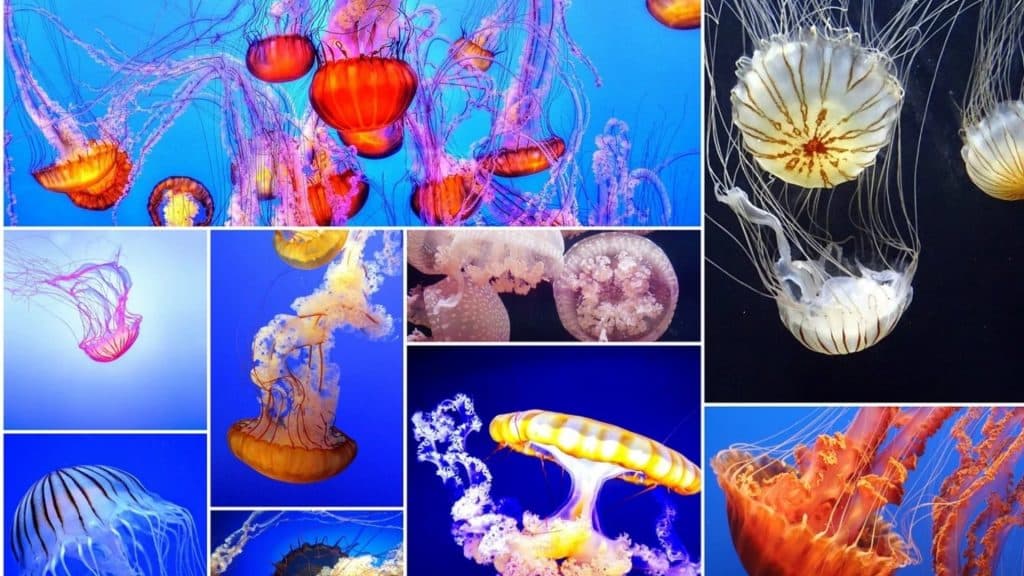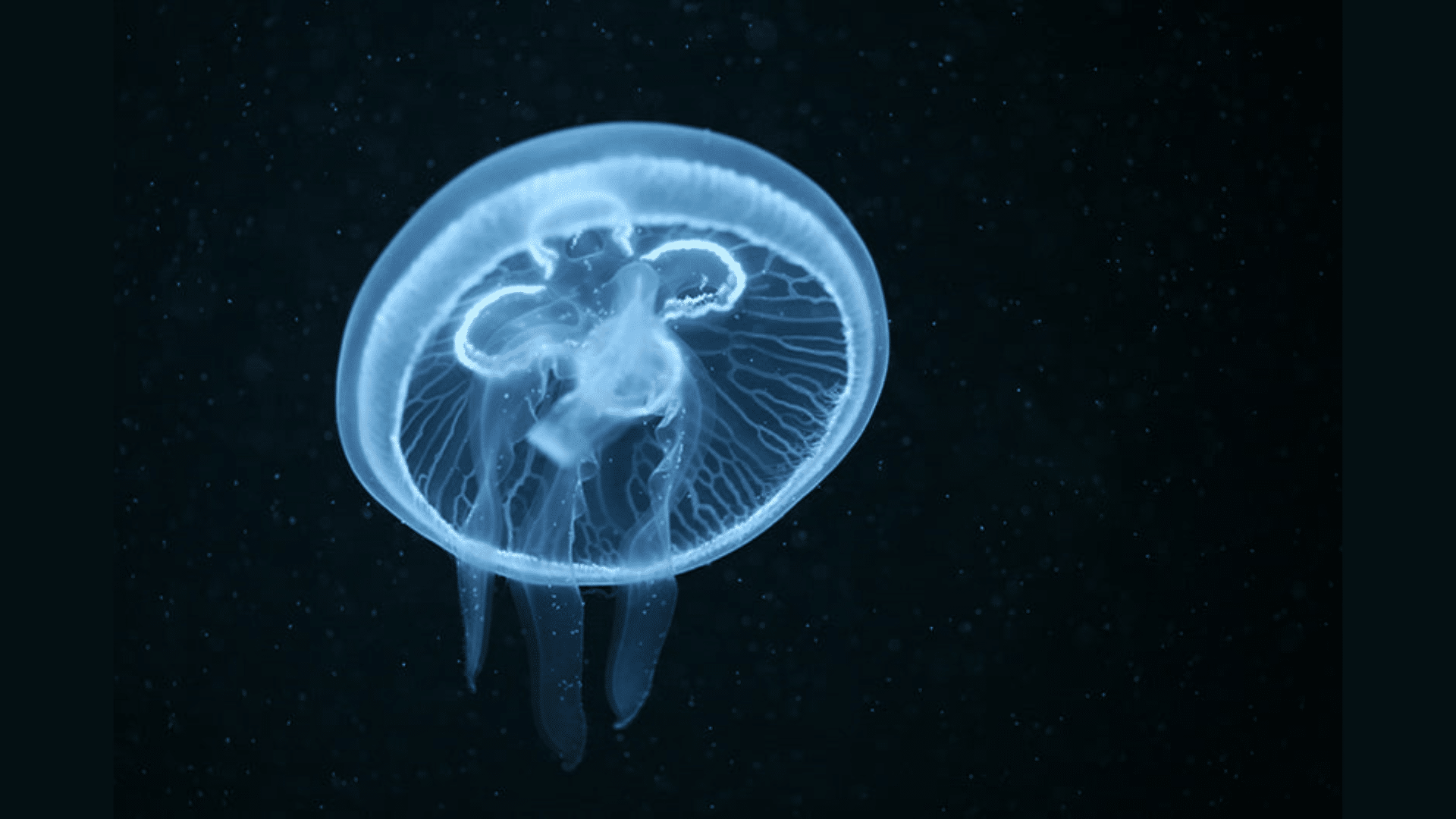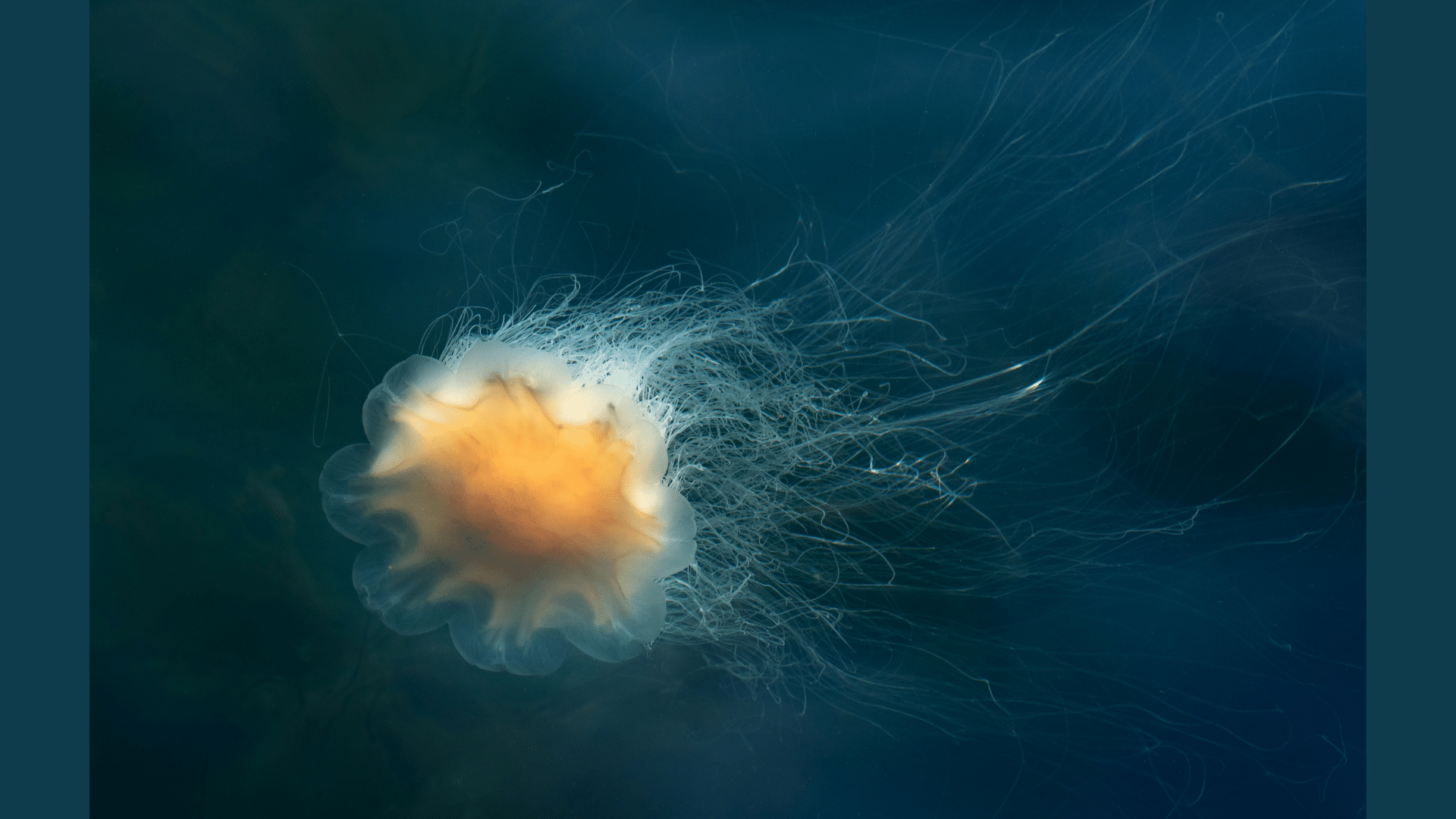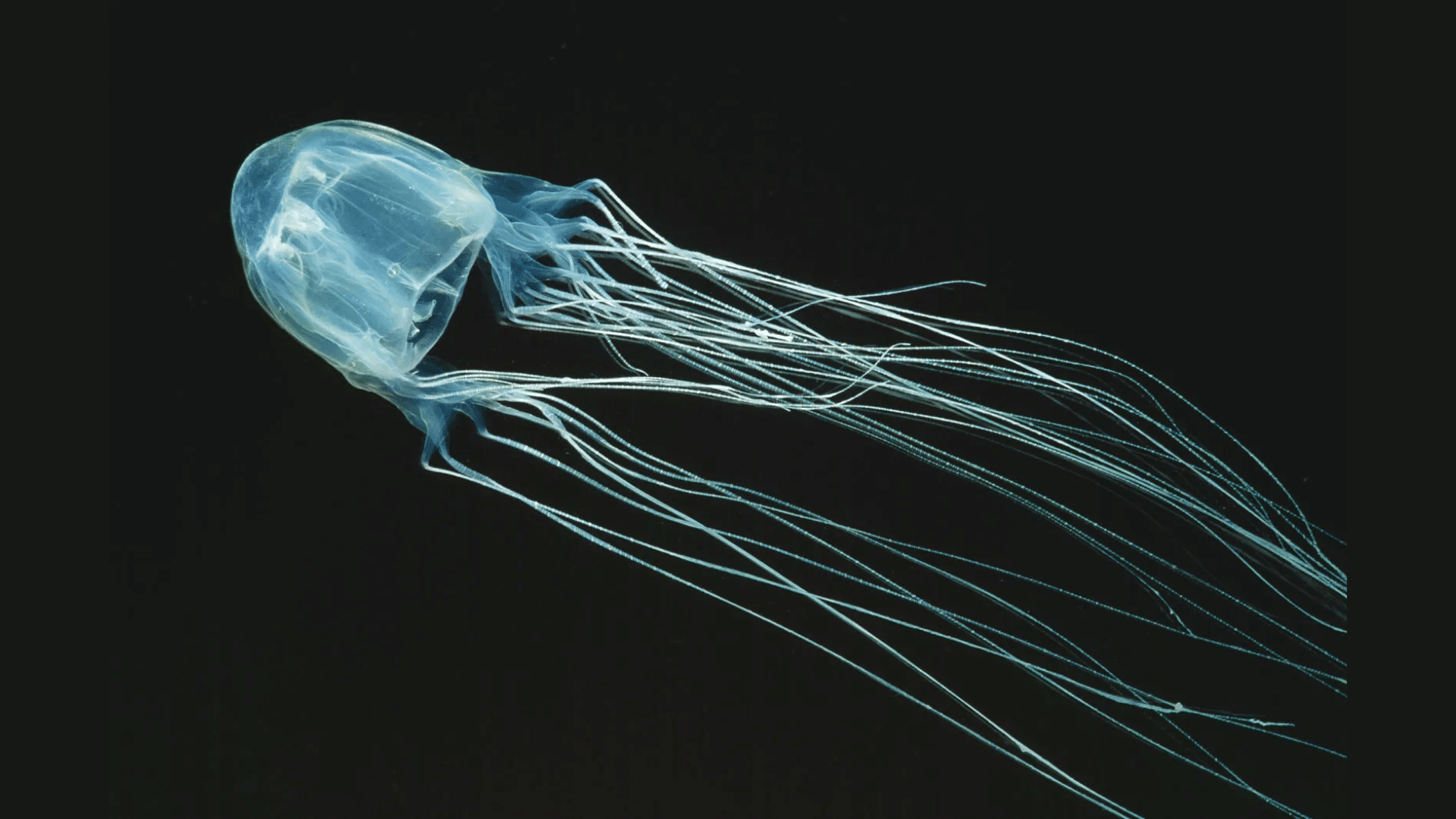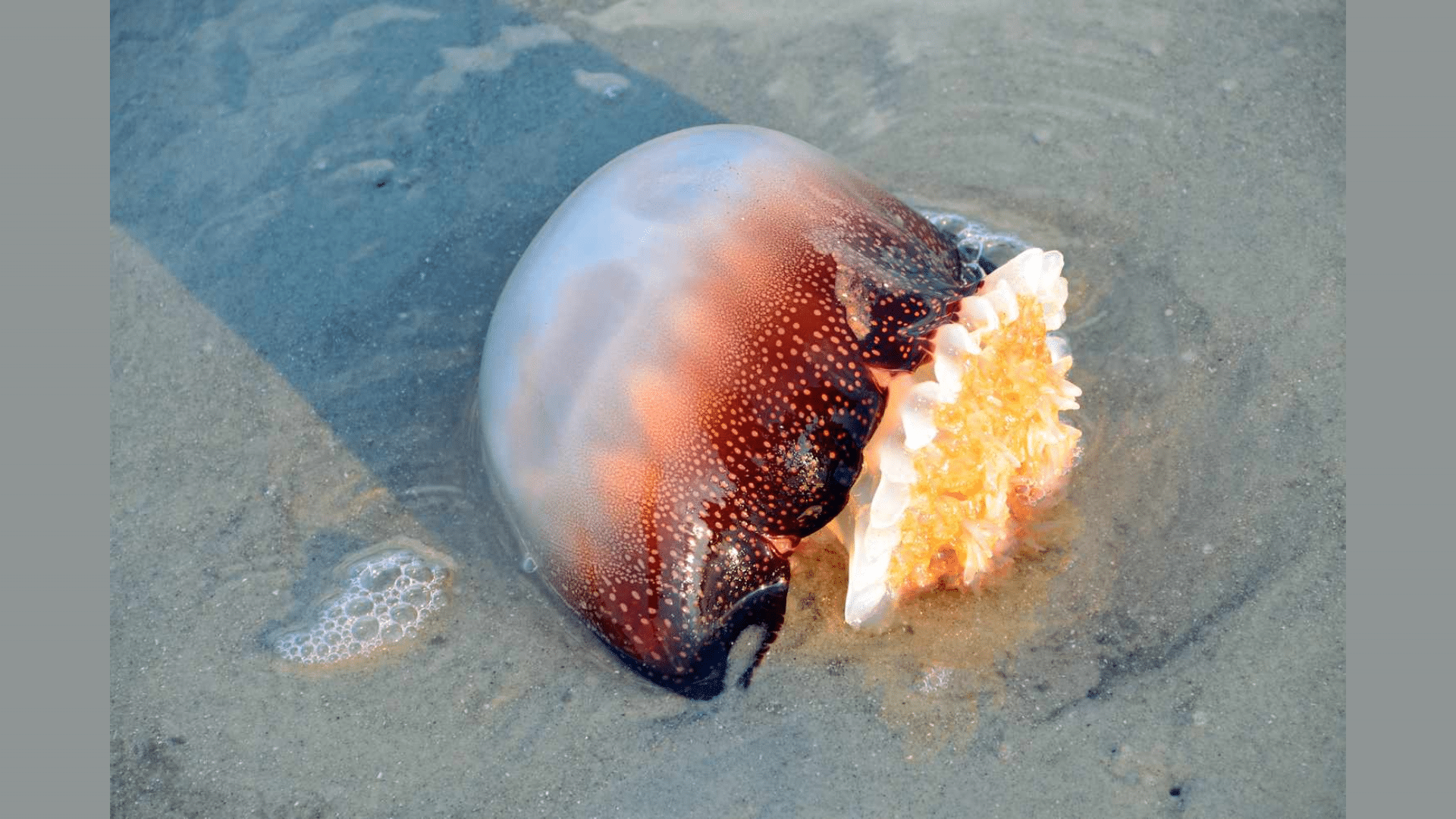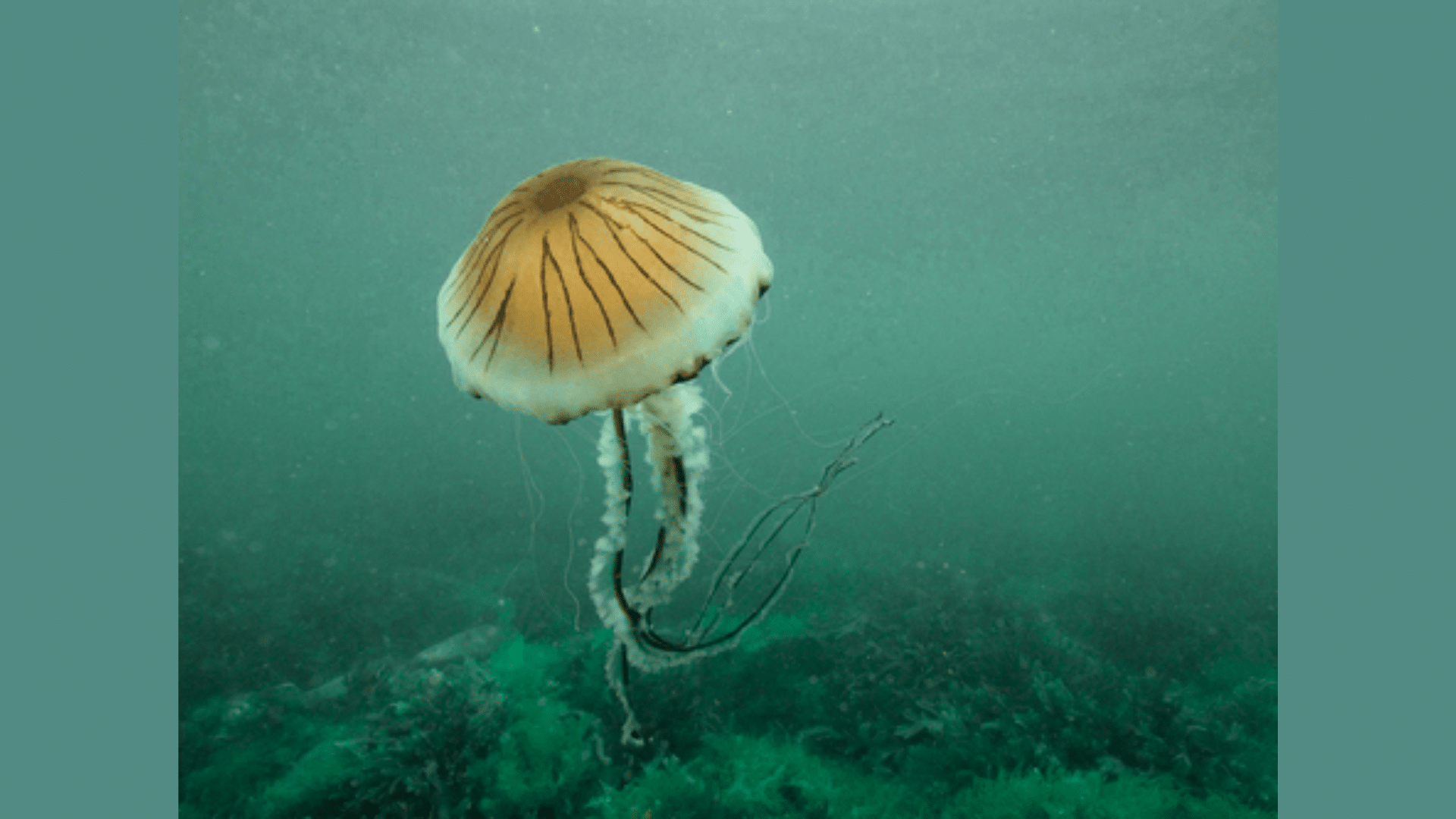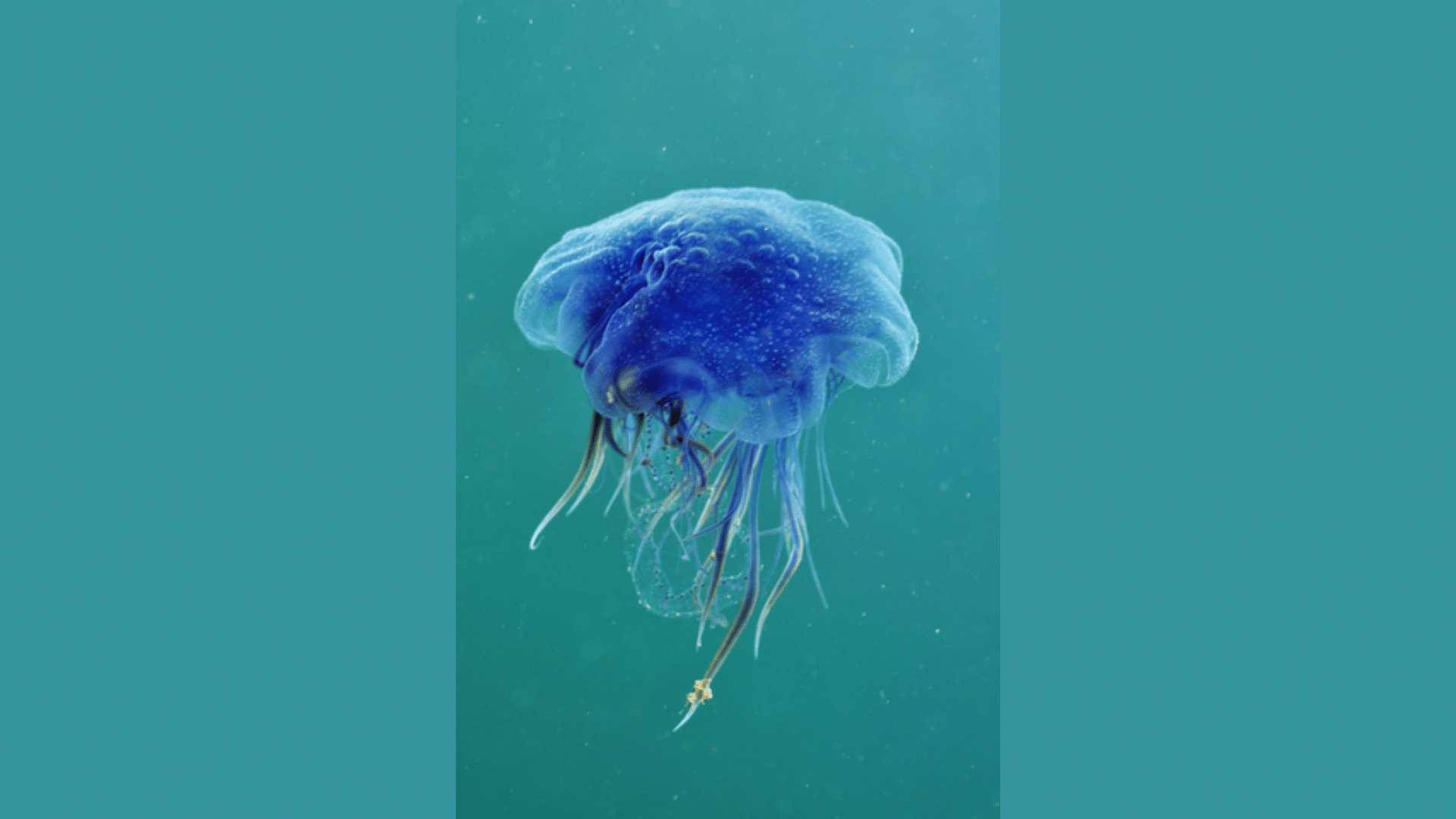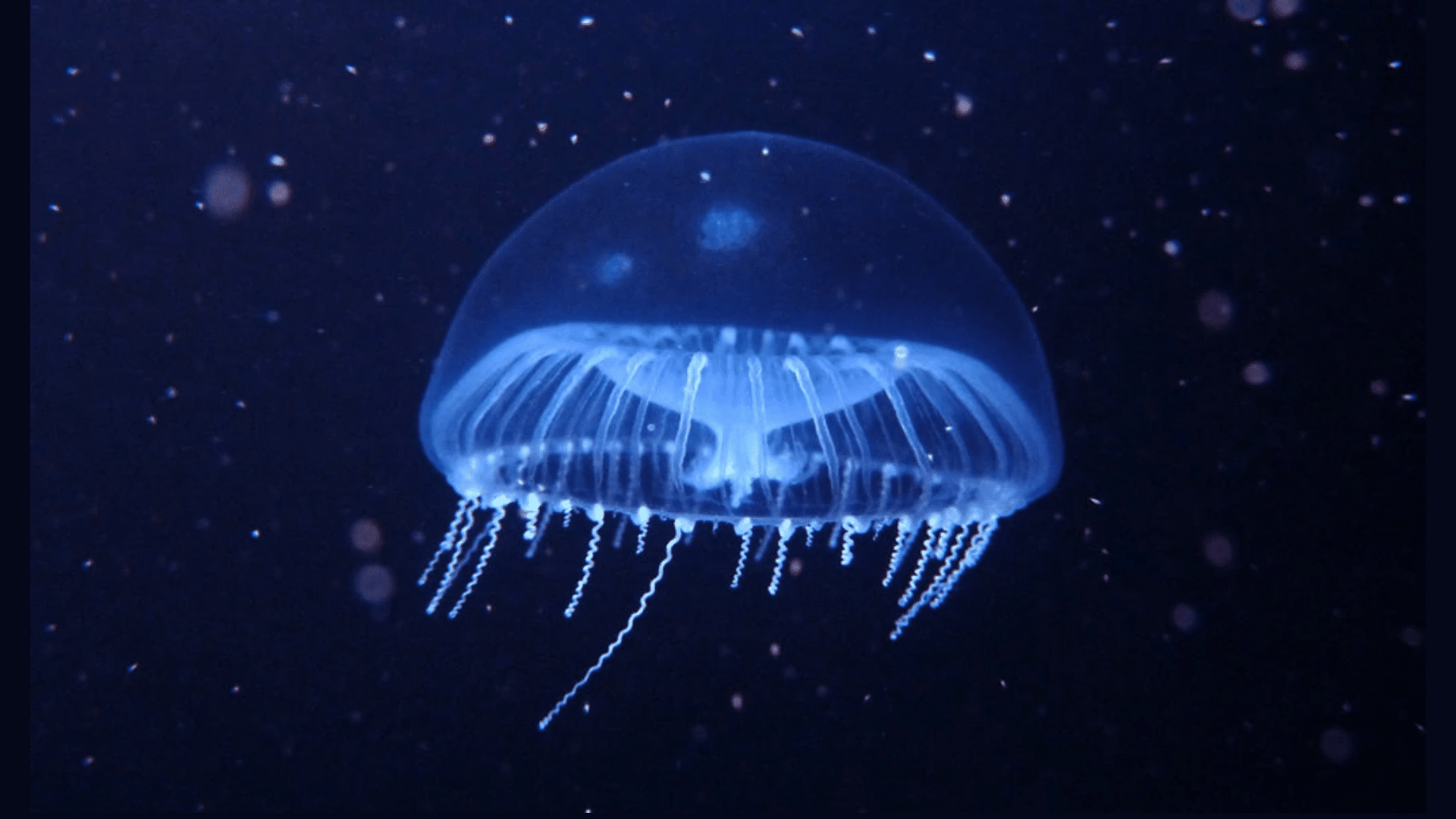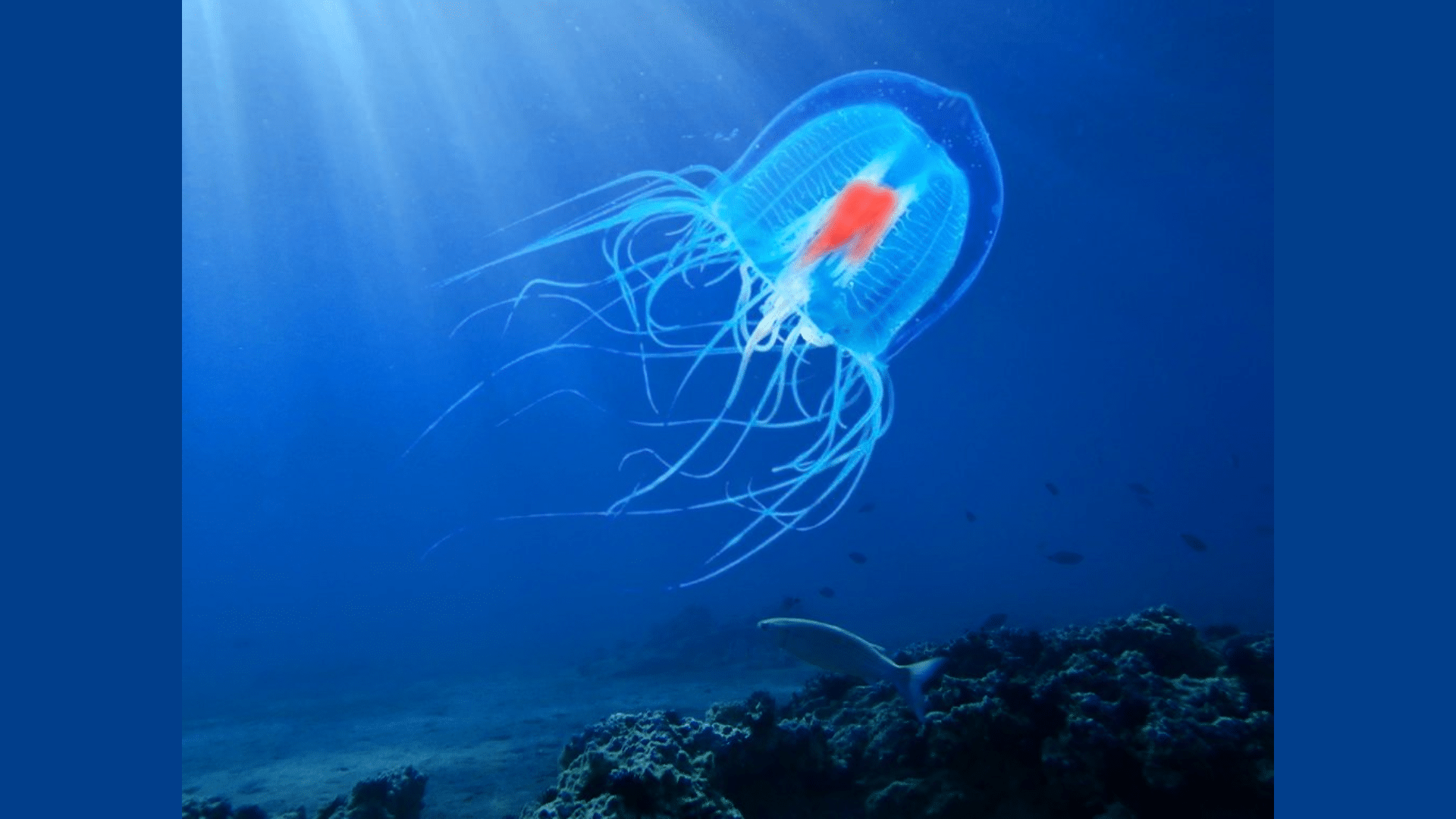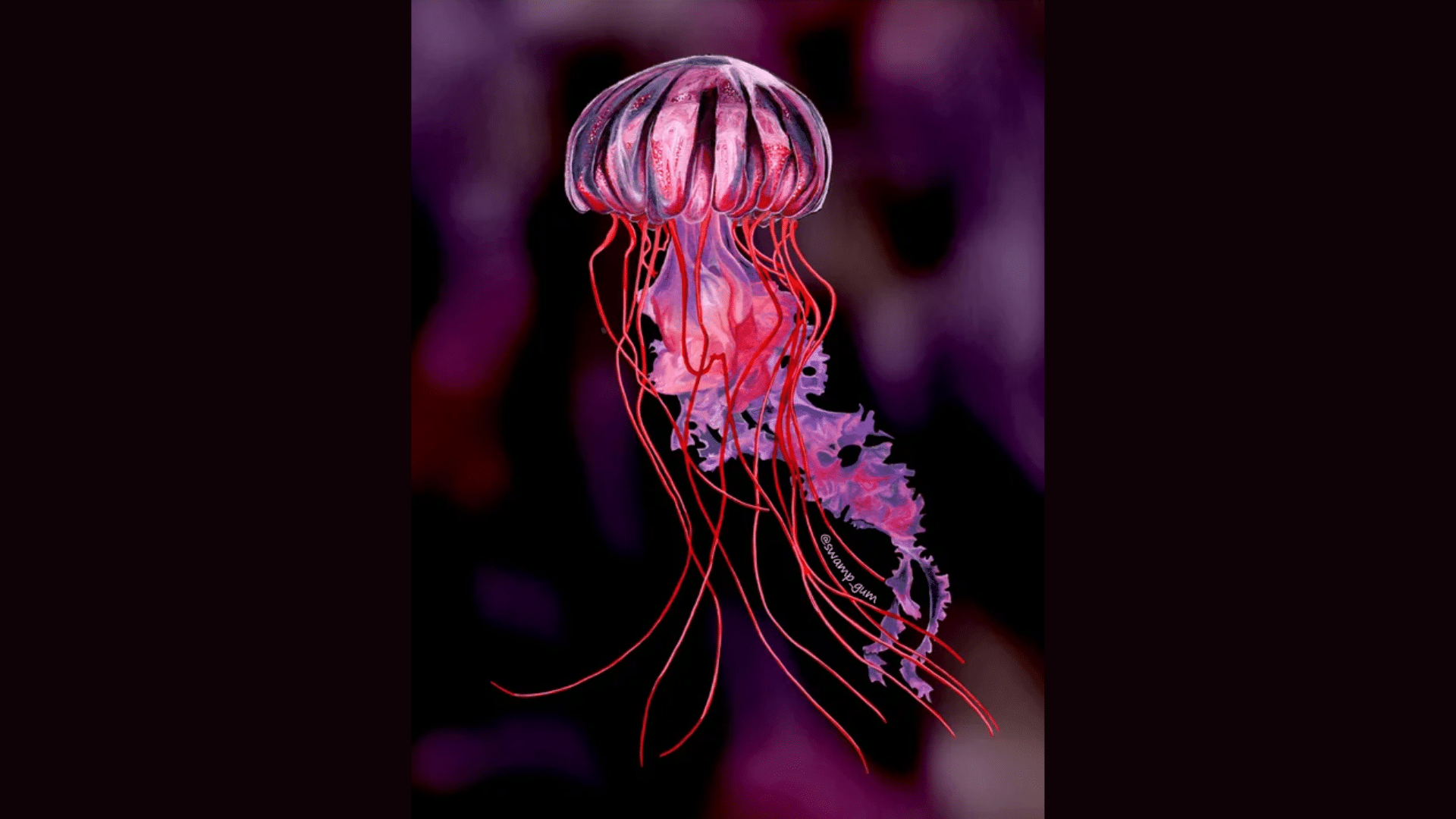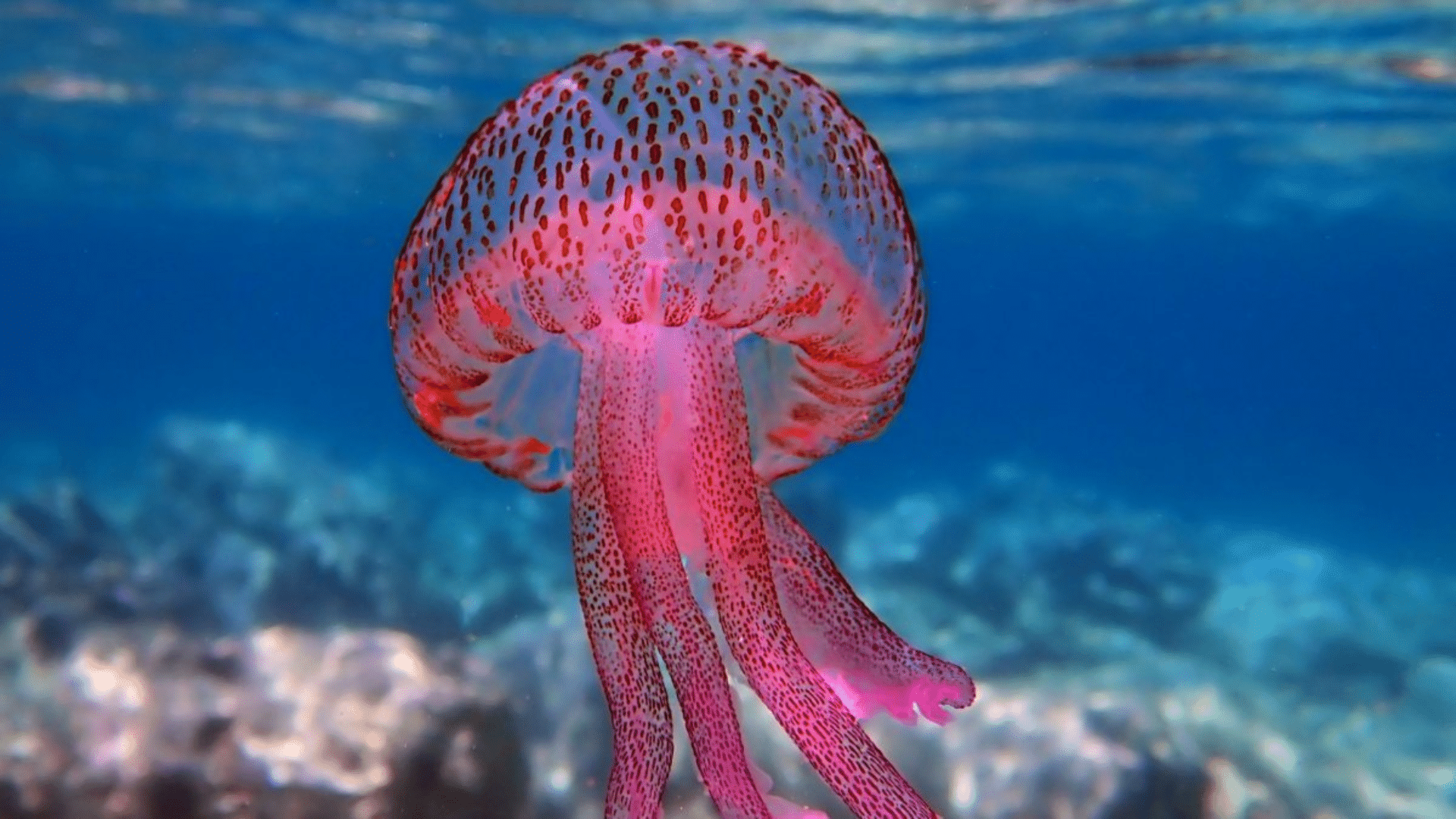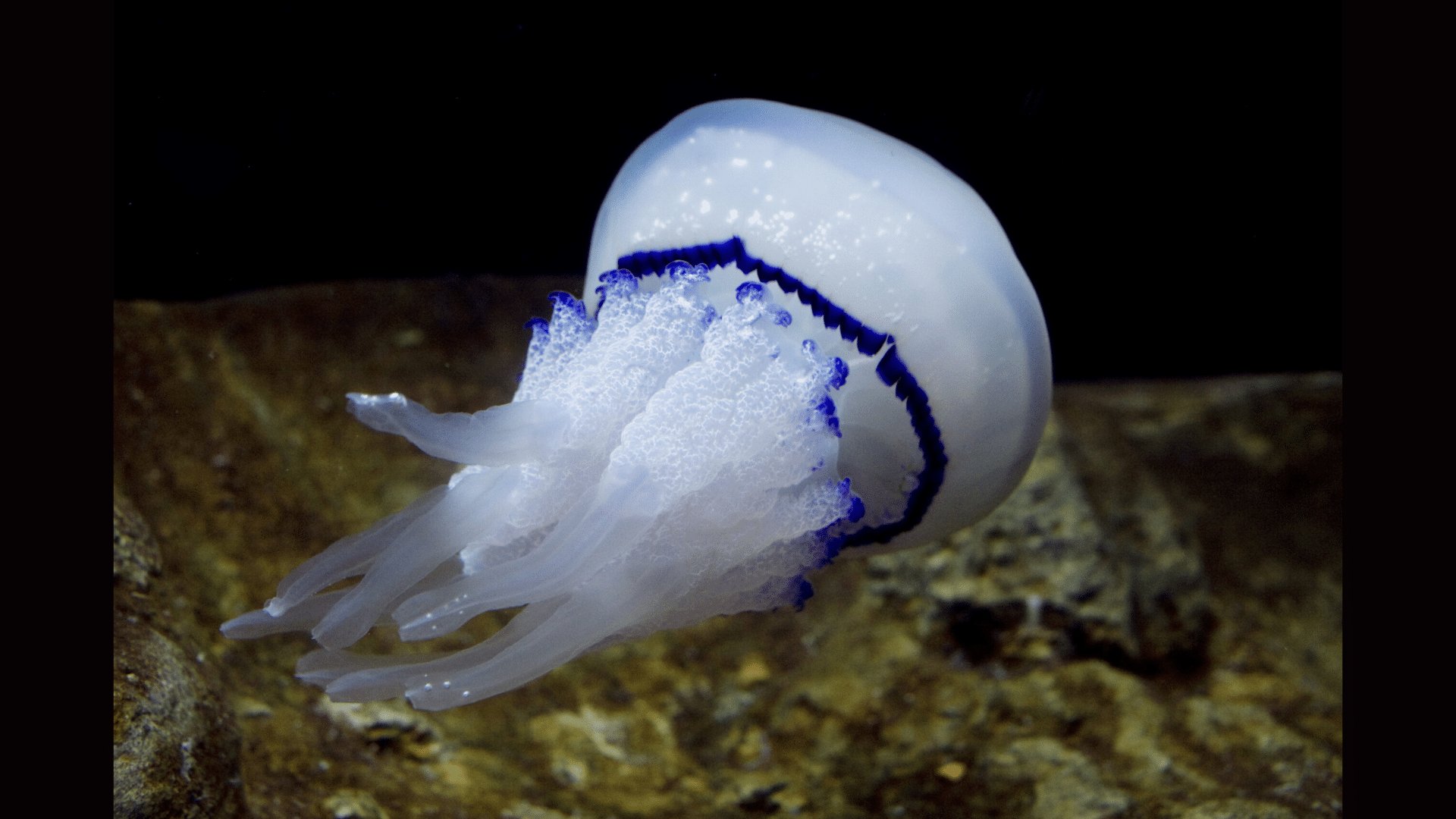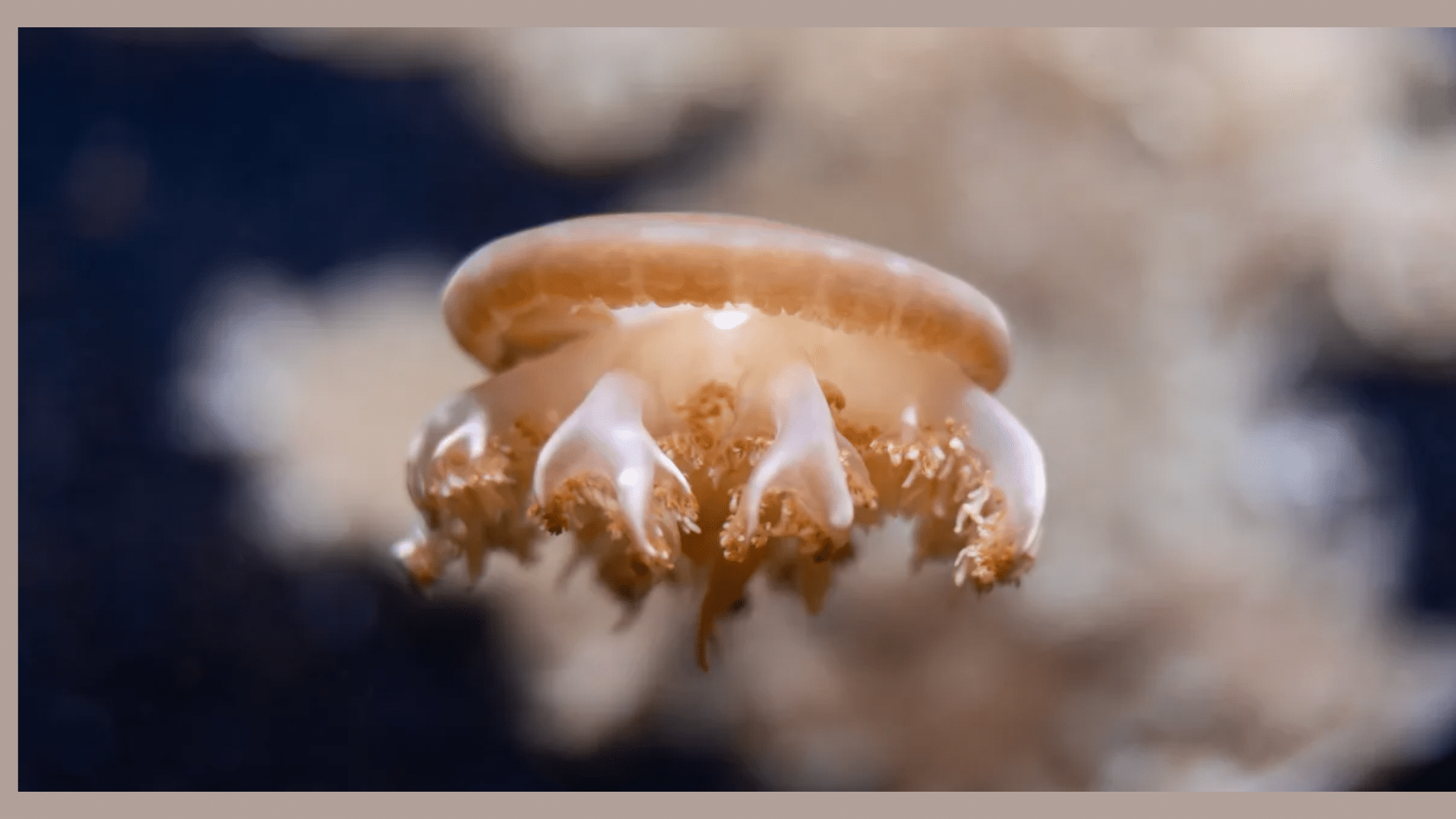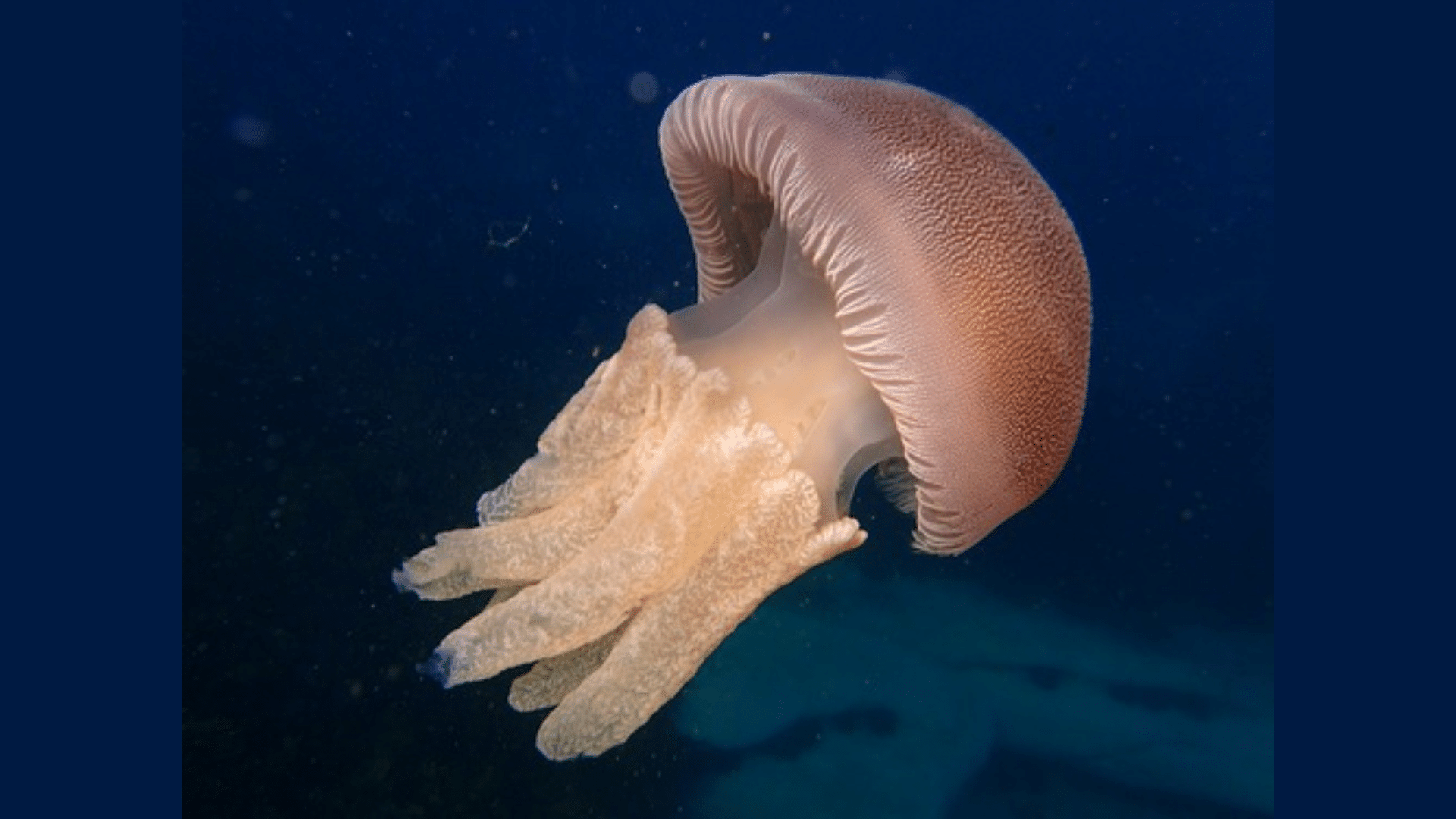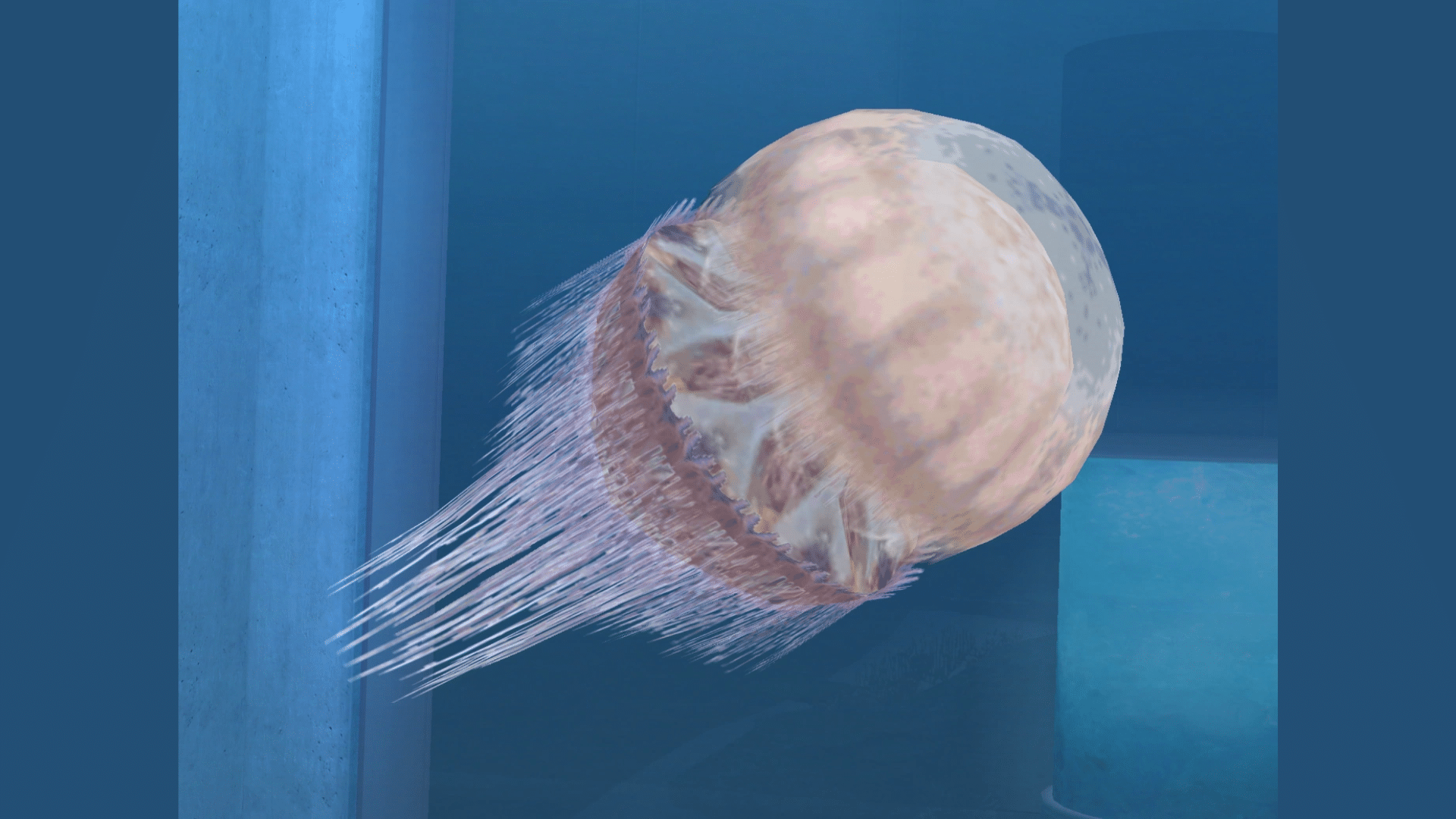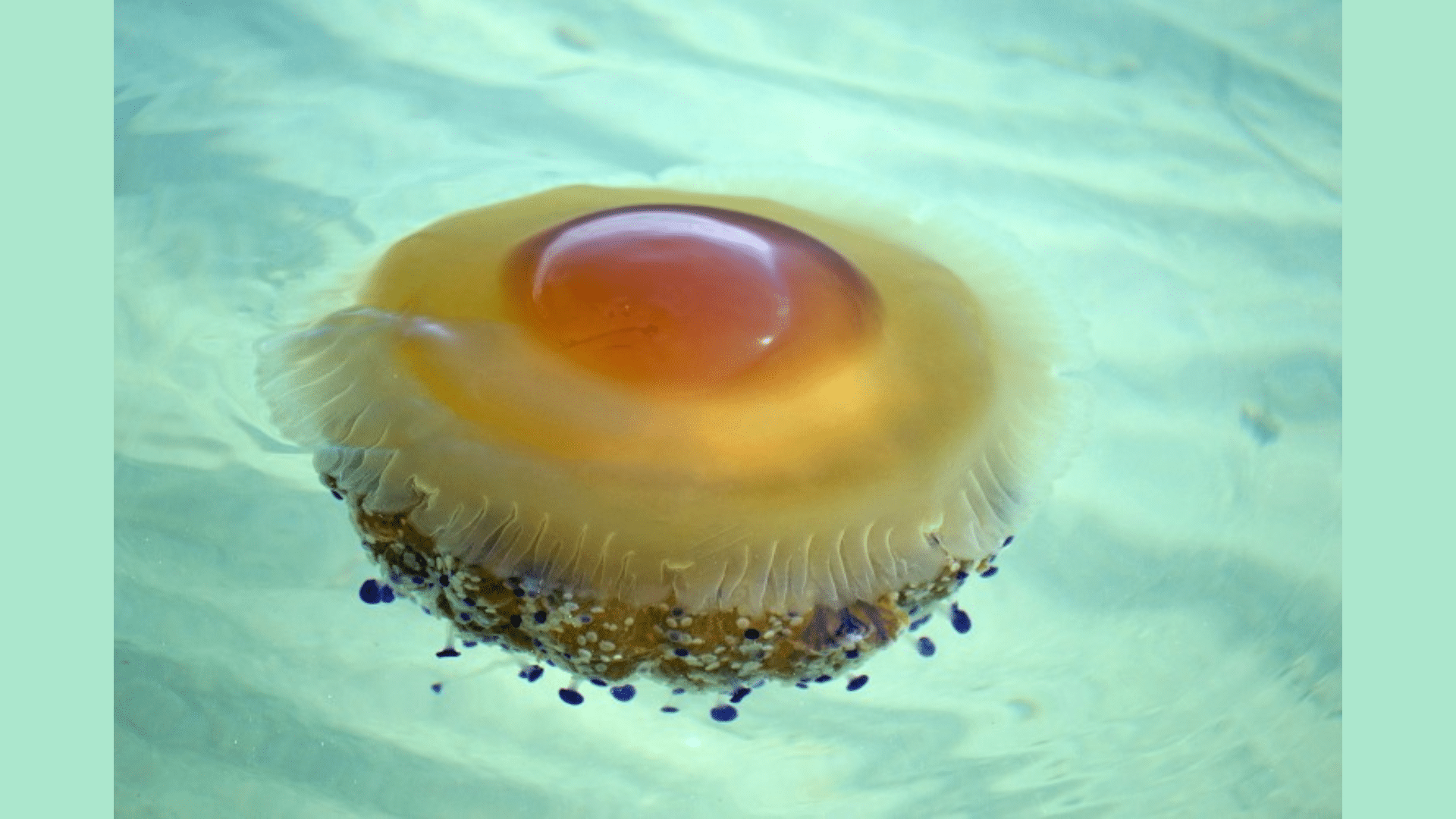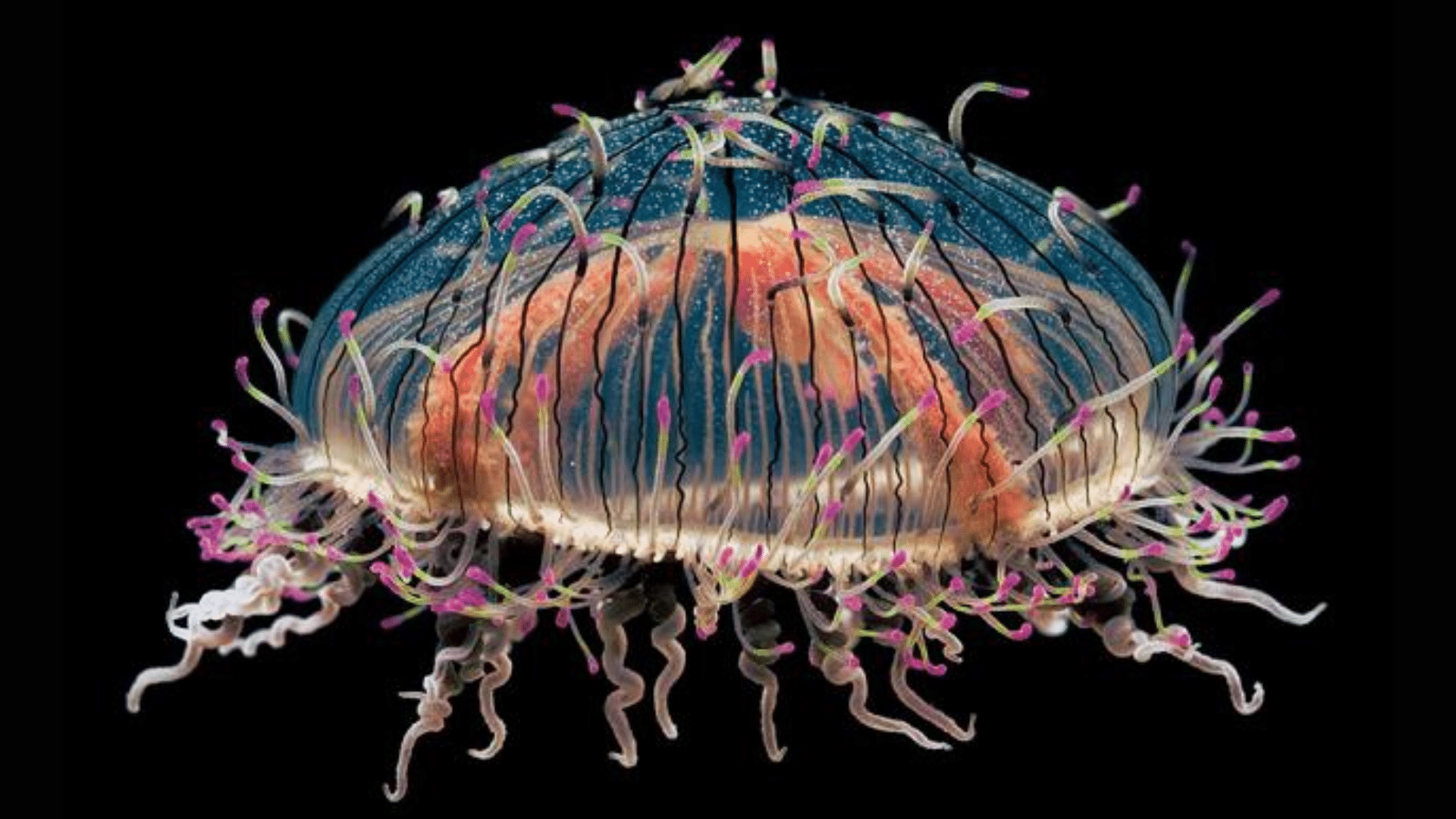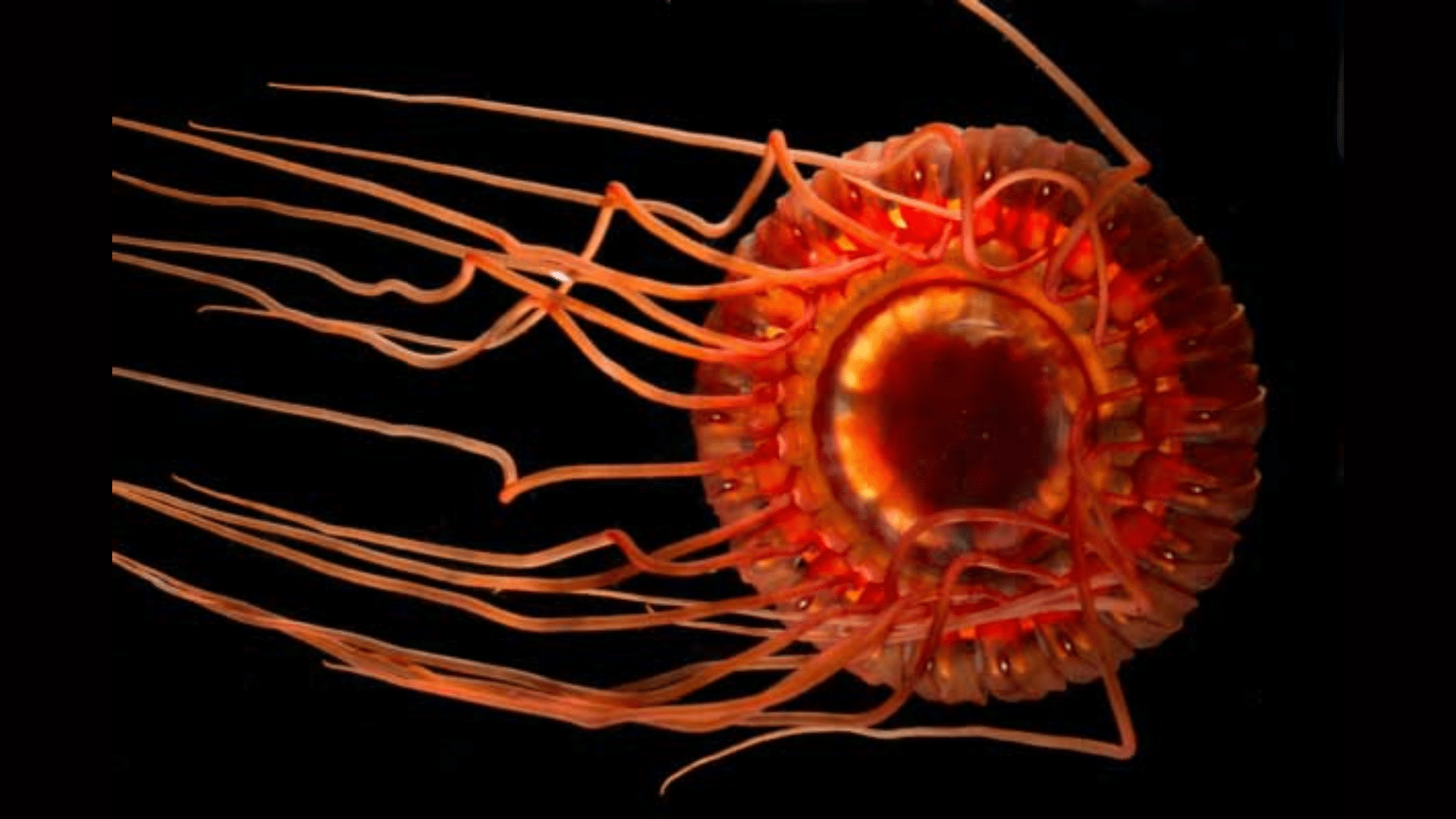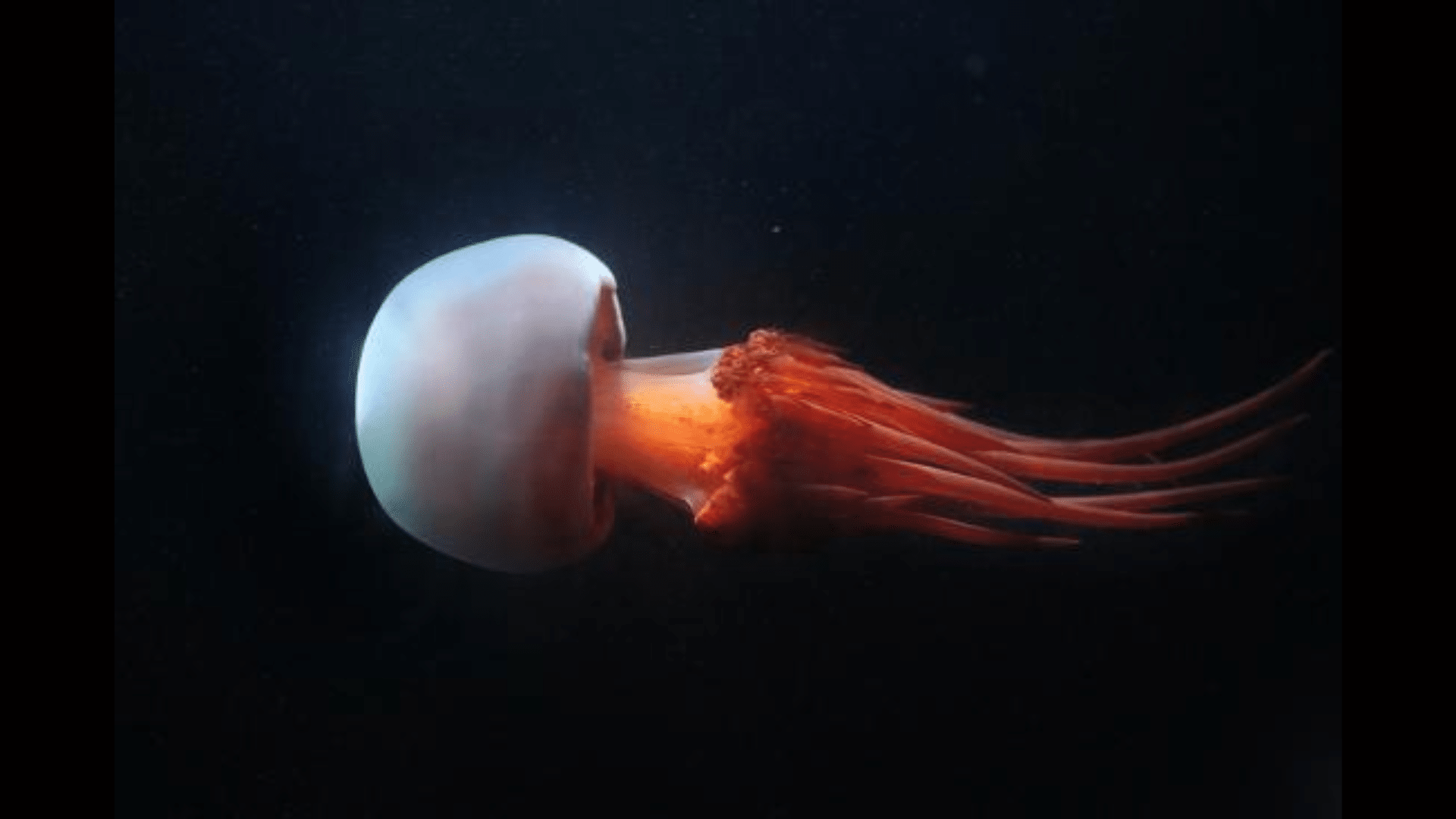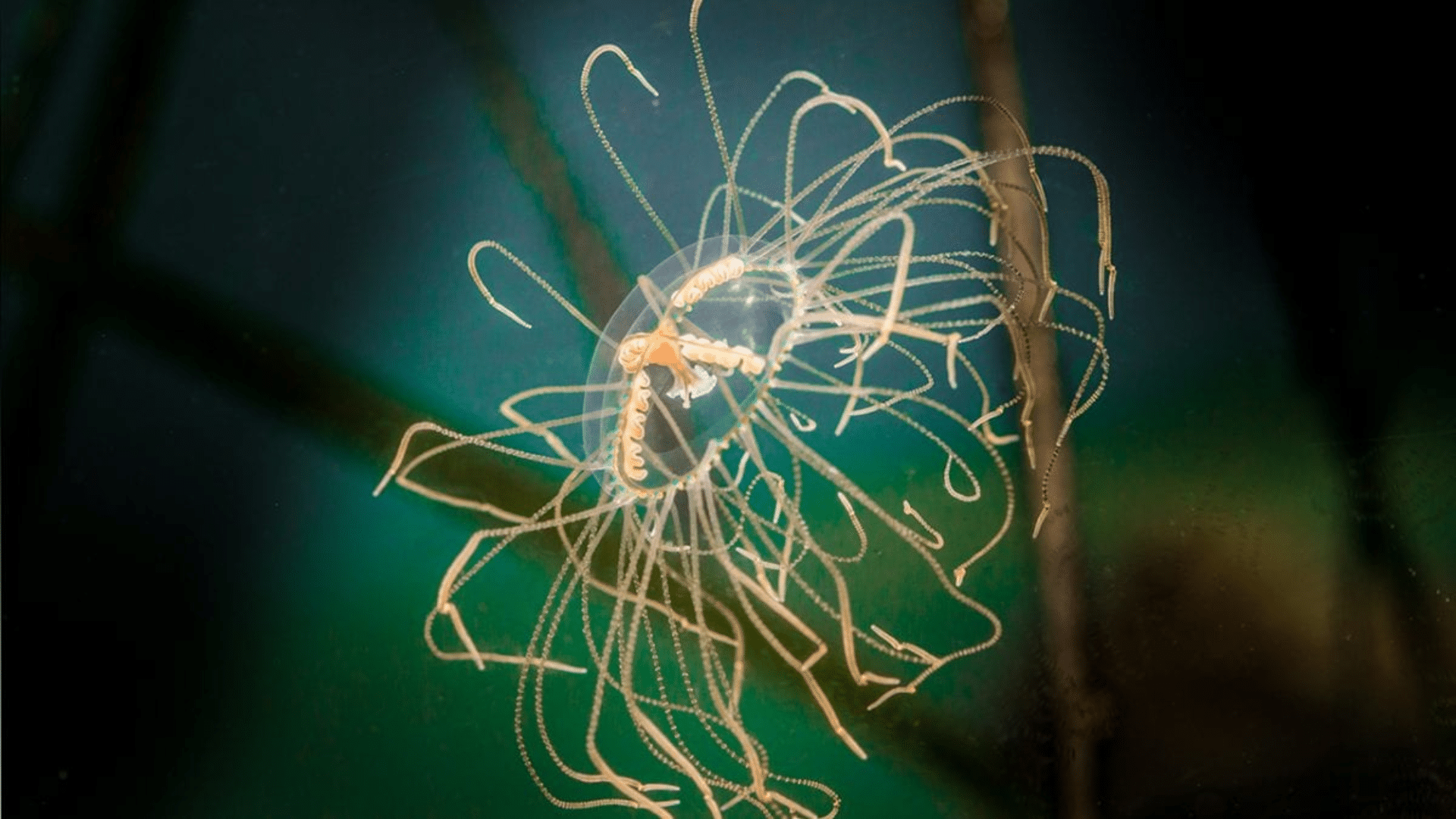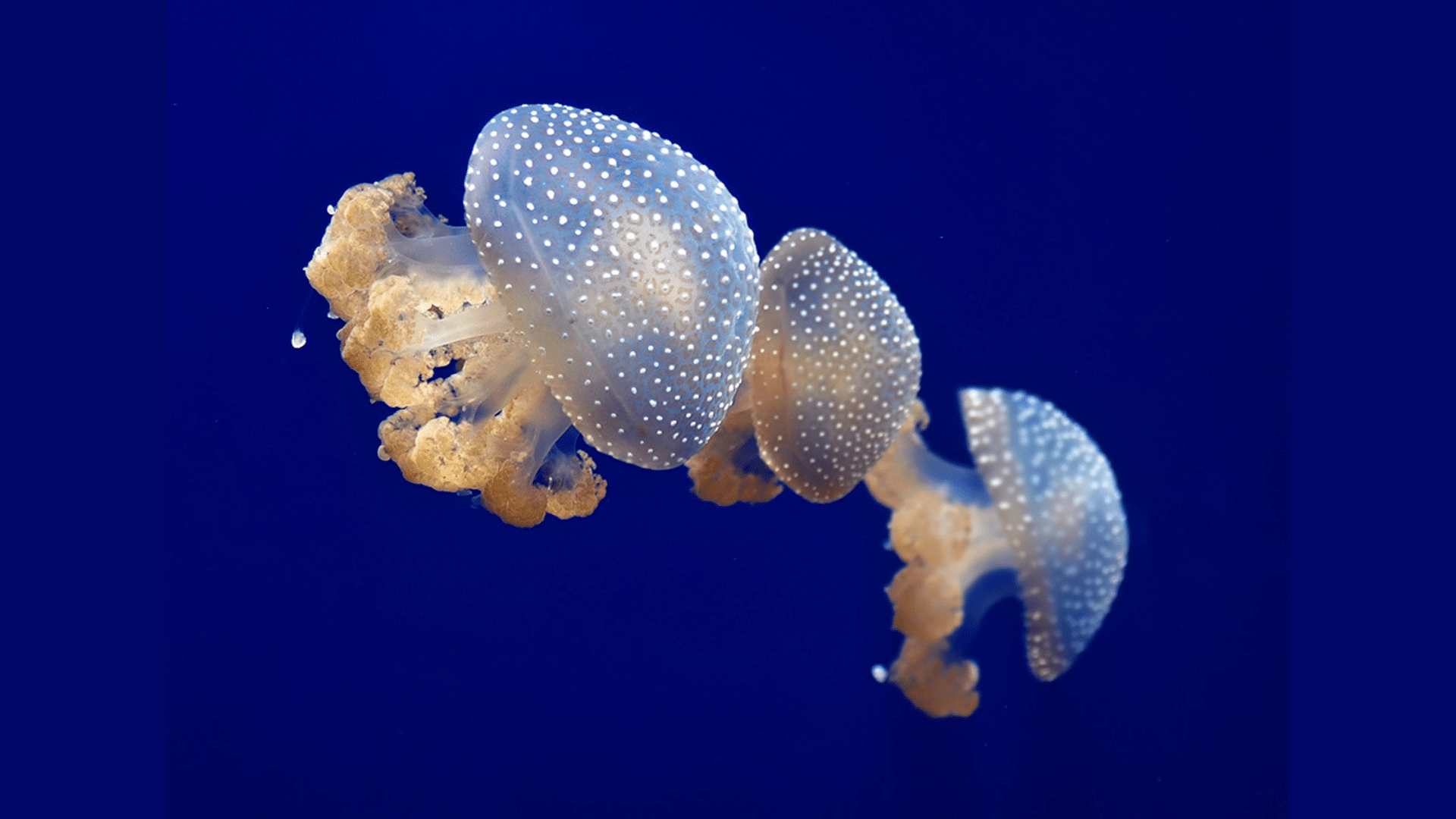Jellyfish have lived in our oceans for over 500 million years. These see-through sea creatures come in many shapes, sizes, and colors. Some are tiny, while others stretch longer than a bus.
Most float quietly through water, using their tentacles to catch food
You will learn what makes each one special, where they live, and which ones might sting. Some glow in the dark, others look like flowers, and a few can even be deadly.
Ready to meet these odd but interesting ocean animals?
Let’s start our tour of these watery wonders.
The Basics of Jellyfish
Jellyfish are a group of water animals without bones, brains, or hearts. These strange creatures have roamed our oceans for millions of years, even before dinosaurs walked the earth.
Their bodies are mostly water, about 95%, which gives them their clear, jelly-like look. Jellyfish move by pushing water away with their bell-shaped tops. They catch food with long, hanging tentacles that can sting.
These tentacles help them grab tiny fish and other small sea life. Jellyfish come in many colors, like pink, blue, yellow, and purple.
Some are as small as a fingernail, while others grow larger than humans. These simple yet tough animals have learned to live in all oceans, from warm waters near beaches to the cold, deep sea.
Common Types of Jellyfish
The ocean is home to many types of jellyfish, each with unique traits and behaviors. Some pose little threat to humans, while others pack a painful or deadly sting.
Below are common jellyfish types you might find in waters around the world, and the list covers small coastal species to massive deep-sea varieties.
1. Moon Jellyfish (Aurelia Aurita)
Moon jellyfish are among the most common types found in coastal waters worldwide. They have a round, plate-like bell with four distinct horseshoe-shaped organs visible through their clear bodies.
These gentle creatures feed mainly on plankton, which they trap in mucus on their bells and move to their mouths with small arms.
Moon jellyfish tend to gather in large groups called blooms, often containing thousands of individuals.
Characteristics
- Size: Typically 10-16 inches in diameter, with a flat, saucer-shaped bell
- Color: Transparent with a hint of blue, pink, or purple
- Tentacles: Short, fine tentacles hanging from the bell’s edge
- Sting: Very mild, often not felt by humans
- Habitat: Found in coastal waters and harbors worldwide, often near the surface
2. Lion’s Mane Jellyfish (Cyanea Capillata)
The Lion’s Mane is one of the largest jellyfish species in the world. It gets its name from the mass of long, hair-like tentacles that hang from its bell, much like a lion’s mane.
These giants feed on small fish, tiny crustaceans, and even other jellyfish.
They live in cooler northern waters, where they can grow to enormous sizes, though smaller versions exist in warmer areas.
Characteristics
- Size: Can reach 6-7 feet in diameter with tentacles up to 100 feet long
- Color: Reddish-brown to dark purple, with younger ones being lighter orange or tan
- Tentacles: Masses of long, thin tentacles divided into eight clusters
- Sting: Painful but rarely deadly; can cause skin irritation and muscle cramps
- Habitat: Cold waters of the Arctic, northern Atlantic, and northern Pacific oceans
3. Box Jellyfish (Chironex Fleckeri)
Box jellyfish are feared for good reason. They’re among the most deadly creatures in the ocean.
Their cube-shaped bell sets them apart from most round jellyfish.
Unlike many jellyfish, they can swim up to 4 mph and have complex eyes with lenses, corneas, and retinas. They hunt small fish and crustaceans rather than simply drifting and filtering food.
Characteristics
- Size: Bell grows up to 10-12 inches across with tentacles reaching 10 feet
- Color: Pale blue and transparent, making them hard to see in water
- Tentacles: Up to 15 tentacles hanging from each corner of the bell
- Sting: Extremely painful and potentially fatal to humans within minutes
- Habitat: Coastal waters around northern Australia and throughout the Indo-Pacific region
4. Cannonball Jellyfish (Stomolophus Meleagris)
Cannonball jellyfish earned their name due to their firm, round shape. They have short oral arms instead of long trailing tentacles.
These jellyfish are a food source in several Asian countries, where they are dried and processed before eating.
Cannonballs pump water through their bells to move, which resembles the firing action of a cannon.
Characteristics
- Size: Bell reaches 4-7 inches in diameter
- Color: Milky white or brown with a smooth, firm dome
- Tentacles: Very short, stubby tentacles with thick oral arms
- Sting: Very mild, generally harmless to humans
- Habitat: Atlantic and Gulf coasts of the United States and Mexico
5. Compass Jellyfish (Chrysaora Hysoscella)
The Compass jellyfish has distinct V-shaped markings on its bell that look like the points on a compass. They have a frilly appearance due to their numerous tentacles and oral arms.
These hunters catch small fish and other jellyfish with their stinging cells. Their numbers often grow during the summer months in coastal areas.
Characteristics
- Size: Bell grows to about 12 inches across
- Color: Yellowish-white bell with brown or purple markings in a compass pattern
- Tentacles: 24 long tentacles plus four frilly oral arms
- Sting: Moderately painful with burning sensation, causing welts and rashes
- Habitat: Northeast Atlantic Ocean, Mediterranean Sea, and North Sea
6. Blue Jellyfish (Cyanea Lamarckii)
Blue jellyfish are smaller cousins of the Lion’s Mane. They have a similar shape but come in shades of blue. Their central dome rises higher than many flat jellyfish.
These creatures feed mainly on plankton and small fish caught in their trailing tentacles. They often wash up on beaches after storms.
Characteristics
- Size: Bell measures 4-8 inches across
- Color: Light blue to deep indigo bell with blue tentacles
- Tentacles: Numerous thin tentacles arranged in eight clusters
- Sting: Moderate pain with possible rash, less severe than Lion’s Mane
- Habitat: Northeast Atlantic Ocean, North Sea, and sometimes the Mediterranean
7. Crystal Jellyfish (Aequorea Victoria)
Due to their extreme transparency, crystal jellyfish are nearly invisible in water. They are known for producing green fluorescent protein (GFP), which is now widely used in medical research.
When disturbed, these jellyfish glow with a beautiful blue-green light.
Scientists study them to better understand bioluminescence in ocean creatures. Using their tentacles, they feed on small marine animals and fish eggs.
Characteristics
- Size: Bell grows to about 4-6 inches in diameter
- Color: Completely transparent with faint white rings on the bell
- Tentacles: Up to 100 fine, short tentacles around the bell’s edge
- Sting: Very mild, rarely noticed by humans
- Habitat: Pacific Ocean from California to Japan, found in deeper coastal waters
8. Immortal Jellyfish (Turritopsis Dohrnii)
The Immortal Jellyfish has earned its name through a unique ability to revert to an earlier life stage when stressed or injured.
These tiny creatures start as polyps, grow into medusae (adult jellyfish), and can change back into polyps to begin the cycle again.
Characteristics
- Size: Very small, only about 0.18 inches in diameter
- Color: Bell is transparent with a bright red stomach visible in the center
- Tentacles: 8-24 tentacles arranged around a small bell
- Sting: Too weak to affect humans
- Habitat: Warm tropical waters worldwide, spreading through ship ballast water
9. Sea Nettle Jellyfish (Chrysaora Quinquecirrha)
Sea Nettles are common in coastal waters during the summer months. They have a distinctive bell with striped markings and long, ribbon-like oral arms.
These active hunters feed on zooplankton, worms, and small fish.
Their population often blooms when water conditions change, creating large groups that can disrupt beach activities.
Characteristics
- Size: Bell measures 6-8 inches across, with tentacles extending several feet
- Color: White to pale pink with reddish-brown stripes or spots
- Tentacles: 24 tentacles plus 4 long, frilly oral arms
- Sting: Moderately painful with burning and skin irritation lasting hours
- Habitat: Atlantic coast of North America, particularly in Chesapeake Bay
10. Mauve Stinger Jellyfish (Pelagia Noctiluca)
The Mauve Stinger stands out for its bright color and ability to produce light. This bioluminescent jellyfish glows blue-green when disturbed at night.
Unlike many jellyfish, it doesn’t have a polyp stage but develops directly from eggs.
These open-water swimmers sometimes wash up on shore in large numbers during storms.
Characteristics
- Size: Small bell around 2-4 inches in diameter
- Color: Pink, purple, or mauve with small brown dots
- Tentacles: 8 long tentacles and 4 long oral arms that look like tentacles
- Sting: Quite painful with a burning sensation that can last for weeks
- Habitat: Mediterranean Sea, Atlantic Ocean, and sometimes Pacific waters
11. Barrel Jellyfish (Rhizostoma Pulmo)
Barrel jellyfish are large, solid creatures with a dome-shaped bell and thick, cauliflower-like arms. Despite their size, they lack the long tentacles seen in other jellyfish.
They feed on plankton by filtering water through their lobed arms. Their size often causes alarm when spotted by swimmers, but they pose little threat.
Characteristics
- Size: Bell can reach 35 inches across, weighing up to 77 pounds
- Color: Milky white or pale blue bell with purple fringe
- Tentacles: No long tentacles, but 8 thick, frilled arms beneath the bell
- Sting: Very mild, usually not harmful to humans
- Habitat: Northeast Atlantic, Mediterranean Sea, and Black Sea
12. Upside-Down Jellyfish (Cassiopea)
Upside-down jellyfish rest with their bells against the seafloor and tentacles facing up. This unusual posture helps them get sunlight for the algae living in their tissues.
These algae perform photosynthesis, providing nutrients to the jellyfish. They pulse their bells to create water flow that brings in food particles and small creatures.
Characteristics
- Size: Bell measures 4-6 inches in diameter
- Color: Varies from brown to blue-green depending on algae content
- Tentacles: Short, branched tentacles that look like fluffy cauliflower
- Sting: Mild irritation caused by mucus rather than direct contact
- Habitat: Shallow tropical waters, often in mangrove areas and lagoons
13. Mushroom Cap Jellyfish (Rhizostoma Luteum)
Mushroom Cap jellyfish have a thick, rounded bell resembling a mushroom cap. They have no trailing tentacles but possess eight thick oral arms.
These gentle giants filter feed on tiny plankton. Though not commonly seen, they sometimes wash up on European beaches after strong storms, creating quite a spectacle.
Characteristics
- Size: Bell reaches 16-24 inches in diameter
- Color: Yellowish-brown with a smooth, firm dome
- Tentacles: No marginal tentacles, but 8 large oral arms with tiny suction mouths
- Sting: Very mild, typically not harmful to humans
- Habitat: Eastern Atlantic Ocean, particularly off Portugal and Spain
14. Nomura’s Jellyfish (Nemopilema Nomurai)
Nomura’s jellyfish are among the world’s largest jellyfish species. They have been known to damage fishing nets and even disable small fishing boats with their massive size and weight.
These giants have become more common in recent years, possibly due to ocean warming. They consume huge amounts of plankton and fish eggs.
Characteristics
- Size: Bell can reach 6.5 feet in diameter, weighing up to 440 pounds
- Color: Light orange or brown with a slightly purple tint
- Tentacles: 8 large, frilly oral arms instead of long tentacles
- Sting: Moderately painful, causing redness and swelling
- Habitat: Waters between China, Korea, and Japan in the East China Sea
15. Fried Egg Jellyfish (Cotylorhiza Tuberculata)
The Fried Egg jellyfish gets its name from its appearance, a yellow center surrounded by a translucent white bell, much like an egg in a frying pan.
They have small bumps on the bell’s surface. These peaceful creatures often host small fish among their short tentacles, providing protection for the fish and cleaning services for the jellyfish.
Characteristics
- Size: Bell reaches 14-16 inches in diameter
- Color: Translucent white bell with a raised yellow-brown center
- Tentacles: Many small, clubbed tentacles with purple tips
- Sting: Very mild, often not felt by humans
- Habitat: Mediterranean Sea, particularly in late summer months
16. Flower Hat Jellyfish (Olindias Formosa)
Flower Hat jellyfish have striking tentacles with colored bands that curve up around their bell. This gives them the appearance of wearing a fancy hat with ribbons.
Unlike many jellyfish, they can rest on the ocean floor. They hunt small fish and shrimp, using their colorful tentacles to attract prey.
Characteristics
- Size: Small bell around 3-4 inches in diameter
- Color: Transparent bell with pink, green, and yellow striped tentacles
- Tentacles: Numerous banded tentacles that curve upward around the bell
- Sting: Painful but not deadly, causing welts and skin irritation
- Habitat: Coastal waters of Japan, Brazil, Argentina, and sometimes California
17. Atolla Jellyfish (Atolla wyvillei)
Atolla jellyfish live in the darkness of the deep ocean, rarely seen by humans. They have one tentacle much longer than the others, called a hypertrophied tentacle.
When threatened, they produce circles of bright blue light, known as the “burglar alarm”, to attract larger predators that might eat whatever is attacking the jellyfish.
Characteristics
- Size: Bell measures 4-6 inches in diameter
- Color: Deep red to dark purple, helping them hide in the deep sea
- Tentacles: Multiple short tentacles plus one extra-long trailing tentacle
- Sting: Unknown effect on humans, as they rarely encounter people
- Habitat: Deep ocean waters worldwide, typically 3,000-13,000 feet deep
18. Flame Jellyfish (Rhopilema Esculentum)
Flame jellyfish are named for their bright orange coloration and the flame-like appearance of their oral arms. They lack the long trailing tentacles seen in many jellyfish.
These large creatures are harvested as food in several Asian countries. They move through water with rhythmic pulses of their bell.
Characteristics
- Size: Bell grows to 10-20 inches in diameter
- Color: Bright orange to reddish-brown
- Tentacles: No long marginal tentacles, but 8 large, frilly oral arms
- Sting: Mild to moderate, causing skin irritation
- Habitat: Western Pacific Ocean, particularly in waters around China and Japan
19. Clinging Jellyfish (Gonionemus Vertens)
Clinging jellyfish are small but pack a painful sting. They get their name from the sticky pads on their tentacles that allow them to cling to seagrass and seaweed.
Unlike most jellyfish that drift freely, these can attach to plants and wait for prey. They’ve expanded their range in recent years, causing concern for swimmers.
Characteristics
- Size: Tiny bell, only 1-2.5 inches in diameter
- Color: Transparent with a green or pink cross pattern on the bell
- Tentacles: 60-90 tentacles with adhesive pads at the tips
- Sting: Very painful, causing severe pain, nausea, and potential breathing problems
- Habitat: Northern Pacific naturally, now found in Atlantic coastal waters
20. White-Spotted Jellyfish (Phyllorhiza Punctata)
White-Spotted jellyfish are filter feeders with small white dots across their brown bells.
They consume massive amounts of plankton, potentially disrupting local food webs when introduced to new areas.
These large jellyfish are native to Australia but have spread to other warm waters. They can form large blooms with thousands of individuals.
Characteristics
- Size: Bell reaches 17-19 inches in diameter
- Color: Brown or bluish with distinctive white dots across the bell
- Tentacles: 8 large, flower-like oral arms instead of long tentacles
- Sting: Very mild, typically harmless to humans
- Habitat: Native to Australia and the western Pacific, now found in the Caribbean and the Gulf of Mexico
Interesting Facts About Jellyfish
Beyond their unusual shapes and colors, jellyfish hold many surprising secrets. These ancient creatures have unique ways to survive and thrive in our oceans.
Here are some interesting facts about these gelatinous sea creatures that might change how you see them.
- Jellyfish have no brains but use nerve nets to sense light, touch, and chemicals. Some even have eyes that see images.
- They have lived for over 500 million years, making them older than dinosaurs.
- Their bodies are about 95% water and can melt away when washed ashore.
- In some Asian countries, jellyfish are dried and eaten in salads, especially the cannonball type.
- Jellyfish don’t chase humans; stings happen by accident when swimmers brush against their tentacles.
- Most jellyfish live only a few months, though the Immortal Jellyfish can restart its life cycle.
- Large groups called blooms can contain thousands or millions and appear due to changes in ocean conditions.
- Some jellyfish glow in the dark using bioluminescence to attract prey or avoid predators.
Final Notes
Jellyfish might look simple, but they are full of surprises that make them one of the most interesting animals in the ocean.
From glowing in the dark to living without a brain, these sea creatures do things most animals can’t, even though they are made mostly of water.
Knowing these interesting facts helps us understand how jellyfish play a crucial role in ocean life and why they are worth learning about.
If you liked these facts, keep exploring; there is so much more to learn under the sea.

